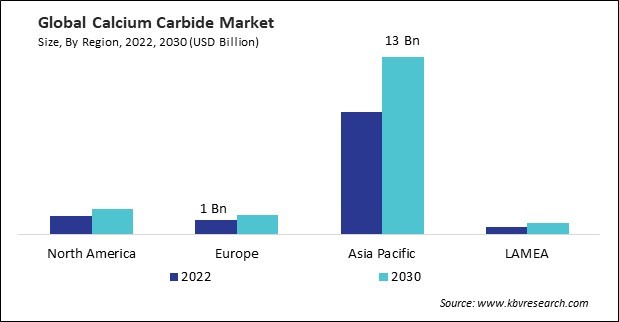According to a new report, published by KBV research, The Global Calcium Carbide Market size is expected to reach $17.1 billion by 2030, rising at a market growth of 4.8% CAGR during the forecast period. In the year 2022, the market attained a volume of 18,215.39 kilo tonnes, experiencing a growth of 4.1% (2019-2022).
The Chemicals segment is leading the Global Calcium Carbide Market, by End-User in 2022; thereby, achieving a market value of $6.2 billion by 2030. The increasing demand for chemicals is driven by population growth, urbanization, technological advancements, changing consumer preferences, regulatory requirements, and emerging markets. Calcium carbide is a key raw material for producing acetylene gas, which is used as a chemical feedstock to synthesize various organic chemicals, including vinyl chloride, acrylonitrile, and acetic acid. It is often more cost-effective than other sources of acetylene gas, making it a preferred choice for many chemical manufacturers.

The Reducing & Dehydrating Agent segment is anticipating a CAGR of 6.8% during (2023 - 2030). Calcium carbide is a strong reducing agent and can react with various metal oxides to reduce them to their respective metals. Calcium carbide is a strong reducing agent, meaning it can donate electrons to other substances, leading to chemical reduction reactions. This property makes it useful in processes requiring reduction, such as producing metals from their ores. Calcium carbide reacts readily with water to produce acetylene gas and calcium hydroxide. This high reactivity makes it an effective dehydrating agent, as it can react with water to remove moisture from a system.
Full Report: https://www.kbvresearch.com/calcium-carbide-market/
The Asia Pacific region dominated the Global Calcium Carbide Market, by region in 2022, and would continue to be a dominant market till 2030; thereby, achieving a market value of $12.9billion by 2030. The North America region is experiencing a CAGR of 4.2% during (2023 - 2030). Additionally, The Europe region would exhibit a CAGR of 4.3% during (2023 - 2030).
By End-User (Volume, Kilo Tonnes, USD Billion, 2019-2030)
By Application (Volume, Kilo Tonnes, USD Billion, 2019-2030)
By Geography (Volume, Kilo Tonnes, USD Billion, 2019-2030)
 Unique Offerings
Unique Offerings